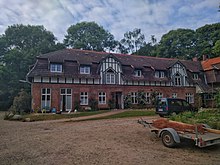Gut Wulfsdorf
Gut Wulfsdorf is a former estate and today's agricultural enterprise in the Ahrensburg district of Wulfsdorf. The Wulfsdorf estate has been owned by the City of Hamburg since 1925. In 1989 the farm was leased to the farmer Georg Lutz and has been managed according to ecological principles ever since.
The former manor house of the estate and the adjoining park with a pond are leased by the Jordsand Association , which has their offices in the building now known as the House of Nature . The park is open to the public.
history
The village of Wulfsdorf was first mentioned in a document in 1238 when the Rennowe family sold Wulfsdorf (then Wuluoldesdorp ) to the Hamburg canons Dietrich and Berthold. In 1256, Berthold donated the entire village to the Hamburg Cathedral Chapter as vicarie . The village of Wulfsdorf thus assumed a special position within the possessions of the Hamburg cathedral chapter.
In the 14th century the village suffered from the disputes between the Hamburg cathedral chapter and the Hamburg council over the boundaries between spiritual and secular power. In 1342 the village was sacked during an attack and only after the chapter dispute had been settled did Wulfsdorf calm down until the middle of the 16th century.
In 1567, the Woldenhorn estate and the four villages belonging to it came into the possession of Daniel Rantzau , who died in 1569. His brother Peter Rantzau inherited the property and built Ahrensburg Castle , which gave the estate its name. Peter Rantzau tried in various ways to get the village of Wulfsdorf under his control. He unlawfully demanded taxes from the Wulfsdorf residents and in 1579 had five Wulfsdorf Hufner and two Kätner arrested because they refused to pay the taxes to him. This breach of the peace was not condemned, however, because in 1581 the Hamburg cathedral chapter had granted the seven-year-old son Peter Rantzaus the dignity of the canon and left him the vicarie of Wulfsdorf.
After the death of Peter Rantzau (1602) protracted legal disputes arose between his widow Margarethe and the Hoisbüttler squire Buchwald around Wulfsdorf. It was not until six years after Margaret's death that the village of Wulfsdorf was finally sold to the Rantzau family.
The Rantzau family ruled over the Ahrensburg estate including Wulfsdorf for the next 120 years. Around 1720, the village of Wulfsdorf was laid down (destroyed), the residents were relocated and the area was turned into a farm for the Ahrensburg estate.
In 1759 the heavily indebted property was sold to Heinrich Karl Schimmelmann in 1759 . His son rescinded serfdom in Wulfsdorf in 1784, parceled out the Wulfsdorf land and leased it to farmers.
It was not until 1873 (now owned by the Koopmann family, who ran a large slaughterhouse in Hamburg) that the estate became independent from Ahrensburg, but was incorporated back into Ahrensburg in 1928.
In 1904 the civil engineer Hermann Vering came into possession of the Wulfsdorf estate after a foreclosure auction, increased the area of the estate through acquisitions and had new buildings built from 1906, including the manor house, stables, water tower, machine house with electricity generation and forge.
After his death in 1922, the city of Hamburg bought the property from the heirs in order to move their children's and youth homes there. However, the far-reaching plans failed due to the effects of the global economic crisis . In the end, only the Tannenheim was built for 60 pupils who were used for agricultural activities on the estate.
In 1989 the Hamburg Senate decided to lease the property on a long-term basis, with the stipulation that organic farming should be practiced here.
present
In addition to biodynamic farming, which includes arable farming and livestock farming, a variety of activities take place at Gut Wulfsdorf. In addition to farm products, the farm shop also sells goods from the Demeter butcher and the Demeter baker, who are also located on the farm. There is also a ceramic workshop. Supported by the Initiativkreis Gut Wulfsdorf eV, the farm offers events and guided tours. Organic seed research is carried out on the farm with the aim of developing vegetable varieties that are adapted to the location and that are grown without the use of biotechnology. There is also an organic beekeeping facility.
Awards
- Promotional award for organic farming, 2007, 3rd prize
- Schleswig-Holstein Sustainability Award, 2015, 2nd prize
- The estate has been a demonstration farm for organic farming since 2009
Web links
Individual evidence
- ^ Günther, Barbara., Hennigs, Burkhard von .: Stormarn Lexikon . Wachholtz, 2003, ISBN 978-3-529-07150-8 .
- ^ Historical working group Ahrensburg (ed.): Historical sheets No. 2: Serfdom in Ahrensburg . 2002.
- ↑ Waldschläger, Heinz .: Around the Bredenbek: a foray through the Holstein-Hamburg past . Schwanenverl, 2002, ISBN 3-936091-01-3 .
- ↑ a b Schreyer, Alf. Wulfsdorf in the Middle Ages . 1986.
- ↑ (-) Yearbook for the Stormarn district (23.2005). 2005. (Article: Güter in Stormarn)
- ↑ Schreyer, Alf. Sixty years ago, Hamburg bought Gut Wulfsdorf, a "city of education" that was to be built here . Hamburg, 1985. (In: Unser Heimat, die Walddörfer: Zeitschr. Für Heimatkunde u. Heimatpflege in d. Hamburg. Walddörfern ud neighboring Stormarn); Messages from "De Spieker", Society for Homeland Care and Local Research in the Hamburgische Walddörfern e. V Hamburg: Hansa-Verlag, No. 3: 40-41 (1985)
Coordinates: 53 ° 39 ′ 32 ″ N , 10 ° 11 ′ 24 ″ E
